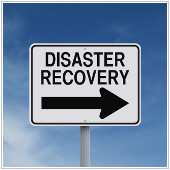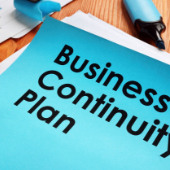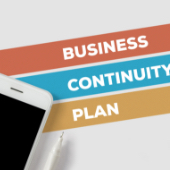Disaster recovery (DR) used to be an expensive solution that relied predominantly on tape backups. Today, cloud computing has dramatically changed the DR landscape, affording even small- and medium-sized businesses cheaper and more reliable DR solutions. Unfortunately, there are still plenty of misconceptions about DR. Here are three myths that no longer apply.
Myth 1: Tape backups are the best DR solution
Tape backups are physical objects that deteriorate over time. Try listening to a cassette tape from the ’90s. Its sound may be distorted already, or it probably doesn’t work at all. Similarly, your tape backups will start to fail over time. At first, only a few files may be affected, but you will gradually lose all your data.
 It is also a common practice to store another set of tape backups outside your premises to secure them in case a natural disaster befalls your office. However, if your storage spaces themselves are unsafe from natural disasters, this could pose a problem.
It is also a common practice to store another set of tape backups outside your premises to secure them in case a natural disaster befalls your office. However, if your storage spaces themselves are unsafe from natural disasters, this could pose a problem.
Unlike tape backups, cloud-based backups are safe from deterioration. They are also stored in multiple secured locations that are protected from natural disasters, so your data backups are as safe as they can be.
What’s more, cloud-based backups save you time in many ways. Data is automatically backed up online, so you don’t need to manually copy information onto your tapes. You also won’t need to manage boxes of tapes, freeing you to focus on more valuable tasks.
Myth 2: The RTOs you want are too expensive
Essential to any DR plan is its recovery time objective (RTO), which is the ideal period when everything must be up and running again to avoid serious losses. Before the cloud, a “swift” recovery time would take days and cost up to six figures.
Cloud and virtualization solutions have made this much faster and affordable than ever before. Most DR providers can back up your critical data in an hour or two. And if you ever need to recover data, most services can do so in less than a day.
Myth 3: Disaster recovery is for big businesses, not SMBs
Due to the astronomical costs previously associated with DR, only big businesses could afford backup and recovery solutions. Thanks to the cloud, however, these have become more affordable for small- and medium-sized businesses (SMBs). From dental offices to small retail operations, SMBs can now take advantage of the best DR solutions in the market. Advances in IT and the cloud have also eliminated the obstacles of complexity, costs, and insufficient IT resources.
We hope that by dispelling these myths, you’d be convinced to implement a disaster recovery plan (DRP) for your business. Thanks to improvements in data storage technologies, it is now more affordable and efficient to implement a DRP, in turn making it easier to ensure BC. If you’d like to learn how our DR solutions can safeguard your business, send us a message and we’ll fill you in.

 A variety of untoward events can disrupt the operations of small- to medium-sized businesses (SMBs), including natural disasters or cyberattacks. These incidents can cause SMBS to lose revenue, or in some extreme cases, close permanently. Fortunately, having a concrete business continuity plan (BCP) in place will help your business recover quickly after a disaster.
A variety of untoward events can disrupt the operations of small- to medium-sized businesses (SMBs), including natural disasters or cyberattacks. These incidents can cause SMBS to lose revenue, or in some extreme cases, close permanently. Fortunately, having a concrete business continuity plan (BCP) in place will help your business recover quickly after a disaster. In the event of a disaster, businesses must make sure that their servers and data are safe. Many companies, however, wrongly assume that merely having data backups guarantees business continuity. Here are other top mistakes companies should avoid when preparing for the worst-case scenario.
In the event of a disaster, businesses must make sure that their servers and data are safe. Many companies, however, wrongly assume that merely having data backups guarantees business continuity. Here are other top mistakes companies should avoid when preparing for the worst-case scenario. As hurricanes are a common event in many areas of the United States, business owners must take steps to secure their data. In this blog, we provide steps that will help you quickly recover your data and get back to business following a hurricane.
As hurricanes are a common event in many areas of the United States, business owners must take steps to secure their data. In this blog, we provide steps that will help you quickly recover your data and get back to business following a hurricane. Do you know why some small- to medium-sized businesses (SMBs) succeed while others fail during the first five years of operation? Poor leadership is one reason, the lack of capital is another. Another big reason is they didn’t prepare for major disruptions, such as natural disasters and cyberattacks, that can bring their business to a grinding halt. This is why you need a BCP.
Do you know why some small- to medium-sized businesses (SMBs) succeed while others fail during the first five years of operation? Poor leadership is one reason, the lack of capital is another. Another big reason is they didn’t prepare for major disruptions, such as natural disasters and cyberattacks, that can bring their business to a grinding halt. This is why you need a BCP. Are you weighing the pros and cons of the cloud for business continuity? Let’s take a closer look at why the cloud is best for this strategy.
Are you weighing the pros and cons of the cloud for business continuity? Let’s take a closer look at why the cloud is best for this strategy. There’s no telling when natural disasters will occur. When they do, certain regions in the country often bear the brunt of their impact, like when Hurricanes Harvey and Irma hit certain states in 2017. With a well-designed disaster recovery (DR) plan, your business can be spared from total devastation.
There’s no telling when natural disasters will occur. When they do, certain regions in the country often bear the brunt of their impact, like when Hurricanes Harvey and Irma hit certain states in 2017. With a well-designed disaster recovery (DR) plan, your business can be spared from total devastation.